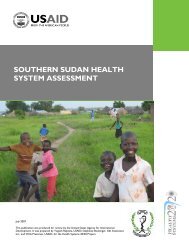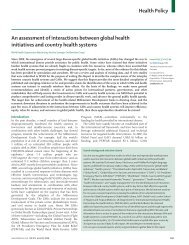PRIVATE SECTOR HEALTH CARE IN INDONESIA - Health Systems ...
PRIVATE SECTOR HEALTH CARE IN INDONESIA - Health Systems ...
PRIVATE SECTOR HEALTH CARE IN INDONESIA - Health Systems ...
- No tags were found...
Create successful ePaper yourself
Turn your PDF publications into a flip-book with our unique Google optimized e-Paper software.
6. US<strong>IN</strong>G F<strong>IN</strong>ANCIAL <strong>IN</strong>CENTIVESTO IMPROVE ACCESS ANDQUALITY6.1 GROWTH OF THIRD PARTY PAYERSIndonesia has historically spent relatively little on health, both from public and privatesources, compared to other countries of similar income and compared to countries in EastAsia. Because of the low level of public spending, the vast majority of public health personnel also workin private practice, and there is a large and flourishing private sector in health care provision includinghospitals, clinics, and private drugsellers. Indonesians tend to pay a large percentage of healthexpenditures out-of-pocket, and often treat themselves, and this private spending is generally paiddirectly from the patient to provider. In a system relying on direct out-of-pocket provider payments,individuals have little leverage or knowledge to assess or enforce provider quality.Despite a long history of health insurance in Indonesia, the growth of coverage has beenrelatively slow until recent years. The civil servants scheme managed by PT Askes was establishedin 1968, and currently covers 4 million government employees plus 11 million of their family members.The scheme for formal sector workers, which was established in 1993 and is managed by PT Jamsostek,has stagnated, and currently covers around 2.9 million workers. In addition, military personnel and theirfamily members were covered by government funding, while other formal sector workers were coveredby voluntary private health insurance.In 2004, the situation changed significantly. First, the Government of Indonesia passed Law 40,which committed itself to achieving universal health insurance coverage. The Government alsoestablished a health insurance program for the poor, Jamkesmas (initially called Askeskin), and this nowcovers 76.4 million people. Many district governments have followed the lead of Jamkesmas andestablished district-based insurance schemes (often called Jamkesda) that cover the near poor. Theseschemes take different forms. Some schemes are designed as extensions of Jamkesmas, with the goal ofcovering an additional population of near-poor, on top of those covered by Jamkesmas. Other schemesfocus on specific services, such as in Yogyakarta, where the assessment team found a scheme coveringMCH services for 104,000 children and pregnant women. There are also a number of very small localinitiatives with various different models in terms of their source of funding, benefit packages and fundmanagement institutions. Lastly, there are a few districts that have announced free health services forall, but the details of funding and benefits are unclear.With the establishment of the Jamkesmas scheme and the district-funded schemes thatfollowed, nearly half of all Indonesians (109 million out of 237 million) are now covered bysome form of health insurance, as shown in Table 3.23
















